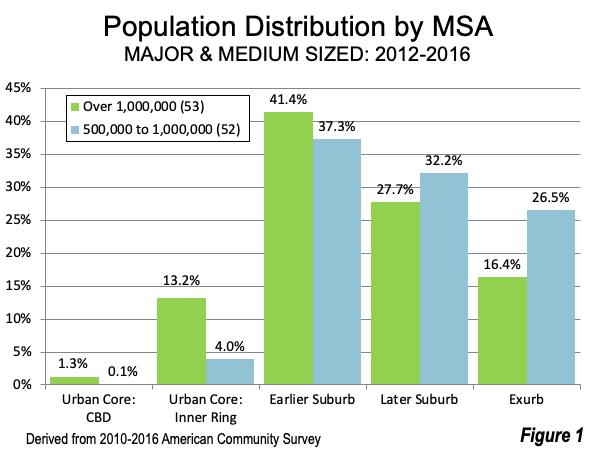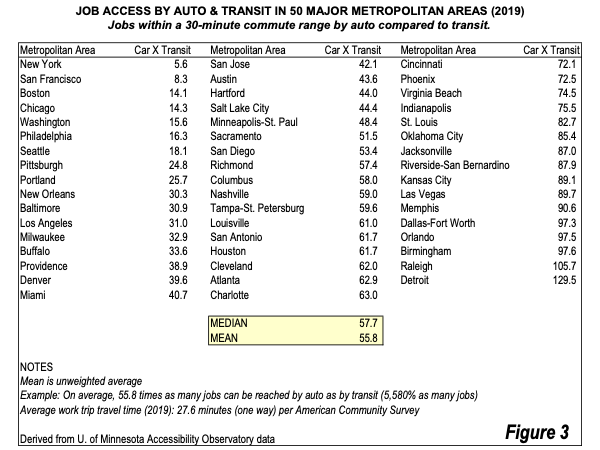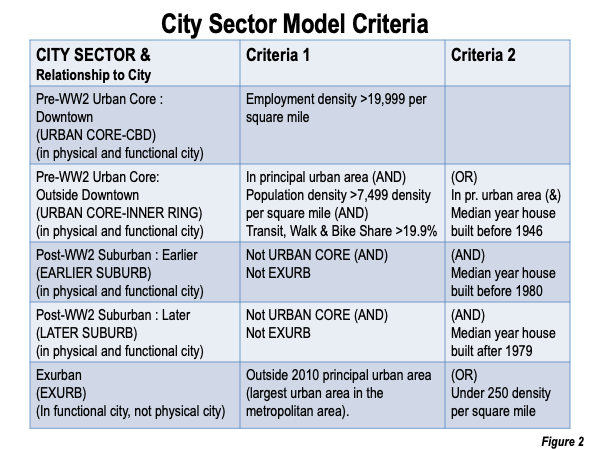America Already has “15-Minute Cities” — on Vehicle Wheels: Fairer, More Efficient and Freer
by Wendell Cox 12/11/2023 – Mirrored 5/20/2024
The Economist argues that automobiles, play a significant role in creating a fairer and more efficient society in the United States. This runs counter to planning orthodoxy but is the lived experience of nearly all Americans. The Economist highlights the fact that many Americans already live in “15-minute cities” of their own, thanks to car-dependent suburban living. This enables quick access to essential services. These research findings directly challenge the traditional planning orthodoxy, which prioritizes high population densities, urban mobility through walking, cycling, transit, and the compact city where neighborhoods are designed for residents to reach essential services within 15 minutes by foot or bike.
The November 9 edition of The Economist magazine featured an article entitled “In praise of America’s car addiction: How vehicle dependence it makes the country fairer and more efficient.” It is hard to imagine a more politically incorrect assertion, yet its research-based wisdom amply demonstrates the frailty of political correctness.
The article cites a study by Prottoy A. Akbar, economics professor at Aalto University, Victor Couture, professor at the University of British Columbia’s Vancouver School of Economics, Gilles Duranton professor of economics at the Wharton School of the University of Pennsylvania and Adam Storeygard, economics professor at Tufts University. The researchers examined 1,200 large urban areas in 152 countries.
The research finds that richer countries enjoy faster urban mobility thanks to their extensive road networks and wider land areas. This growth in infrastructure and urban footprint occurs alongside economic development. In other words, faster mobility in richer countries is primarily driven by their car-centric culture and low-density urban form (the theological term is “sprawl”), which expands with population growth.
Challenging the Planning Orthodoxy
These research findings directly challenge the traditional planning orthodoxy, which prioritizes high population densities, urban mobility through walking, cycling, transit, and the compact city The Economist also points to the recently promoted “15-minute city” model, where neighborhoods are designed for residents to reach essential services within 15 minutes by foot or bike.
There is no question that this is possible in some places. The ville de Paris comes to mind, though not the metropolitan area, which is the commuting shed (the French census bureau [INSEE] term is “aire urbaine”) or the continuously build up urban area (the French term is “unite urbain”). At a population density of 52,000 per square mile or 20,000 per square kilometer, the ville de Paris is an enclave with 2.1 million residents (down from 2.9 million in 1921), comprising less than 20% of the urban area population (10.9 million) and 16% of the metropolitan area (13.0 million). Not surprisingly Parisians rely substantially (about 50%) on cars due to the dispersed nature of the metropolitan area.
America’s 15-Minute Cities on Wheels
The Economist highlights the fact that many Americans already live in “15-minute cities” of their own, thanks to car-dependent suburban living. This enables quick access to essential services.
The Economist notes that more than half of US residents live in suburbs, adding that most of American suburbia “more closely resembles Wichita, Kansas and Greensboro, North Carolina, where drivers rarely face (traffic) jams.”
Many US core municipalities have large swaths of car-oriented suburbanization. Our “City Sector Model,” which relies on urban form and auto orientation, estimates that at 87 percent of residents in the metropolitan areas over 1,000,000 population living in suburban urban forms, and among the more than 50 metropolitan areas with between 500,000 and 1,000,000, more than 95% of residents lived in suburban urban forms (Figures 1 & 2). Outside these areas, the suburban or exurban form would be even more dominant.

Productivity and Economic Opportunity
The article argues that faster travel speeds and less congested roads contribute to more productive urban areas. It cites research indicating that cities in richer nations invest more in fast roads, financed by higher tax revenues, and enabled by higher incomes. This allows for lower population density, which further enhances travel speed.
It is unfortunate that The Economist does not cite research by the University of Minnesota on access to jobs. This research demonstrates that, even in the transit-rich New York metropolitan area, six times as many jobs are accessible within 30 minutes by car compared to transit. This disparity rises to nearly 60 times on average for the approximately to metropolitan areas with more than 1,000,000 population (Figure 3). Access to jobs is crucial to improving the lives of all.>

Conclusion
The authors conclude that their paper reveals a previously undocumented, first-order relationship between a country’s economic development and the speed of vehicle traffic in its urban networks.
Overall, The Economist article argues that automobiles, while often criticized, play a significant role in creating a fairer and more efficient society in the United States. This runs counter to planning orthodoxy but is the lived experience of nearly all Americans.
Wendell Cox is principal of Demographia, an international public policy firm located in the St. Louis metropolitan area. He is a founding senior fellow at the Urban Reform Institute, Houston, a Senior Fellow with the Frontier Centre for Public Policy in Winnipeg and a member of the Advisory Board of the Center for Demographics and Policy at Chapman University in Orange, California. He has served as a visiting professor at the Conservatoire National des Arts et Metiers in Paris. His principal interests are economics, poverty alleviation, demographics, urban policy and transport. He is co-author of the annual Demographia International Housing Affordability Survey and author of Demographia World Urban Areas.
Mayor Tom Bradley appointed him to three terms on the Los Angeles County Transportation Commission (1977-1985) and Speaker of the House Newt Gingrich appointed him to the Amtrak Reform Council, to complete the unexpired term of New Jersey Governor Christine Todd Whitman (1999-2002). He is author of War on the Dream: How Anti-Sprawl Policy Threatens the Quality of Life and Toward More Prosperous Cities: A Framing Essay on Urban Areas, Transport, Planning and the Dimensions of Sustainability.
Photos: John K via Flickr under CC 2.0 License.


